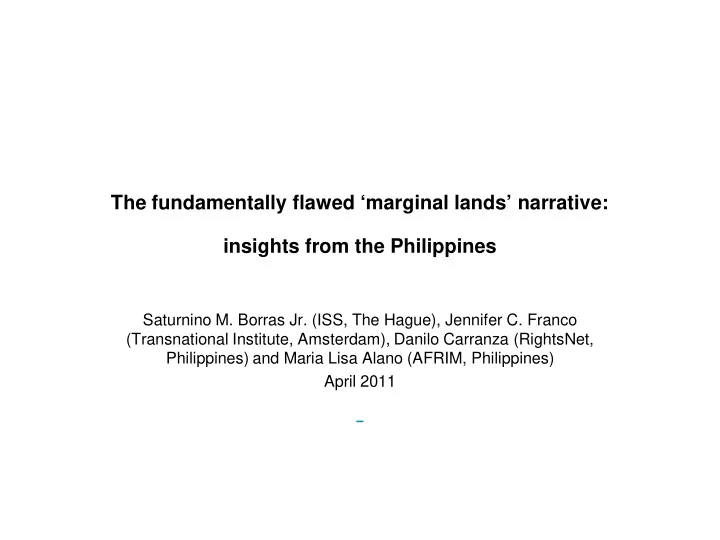

The fundamentally flawed ‘marginal lands’ narrative: insights from the Philippines Saturnino M. Borras Jr. (ISS, The Hague), Jennifer C. Franco (Transnational Institute, Amsterdam), Danilo Carranza (RightsNet, Philippines) and Maria Lisa Alano (AFRIM, Philippines) April 2011
argument: • the narrative about the existence of available marginal lands – defined as thinly inhabited, unproductive, under-productive, under-utilized, idle lands that can be transformed into zones of production for food and biofuels to solve the world’s problem on food and energy without undermining local food needs – is fundamentally flawed. • Such categorization of land hardly exists in the real world, at least not in the context of the Philippines. • We argue that the ‘marginal land narrative’ is based on fundamentally flawed assumptions, using fundamentally flawed ways to identify and quantify. • However, counter-narratives claiming that acquiring these lands in the context of recent land investments and global land grabbing will result in the displacement and dispossession of poor people is only partly correct. • Looking at the dynamics and trajectories of land use and land property relations change in these contested spaces, we can detect diverse, multiple, dynamic and fluid – not singular and static – change trajectories.
The Eco-Global case in Saranggani
San Miguel-Kuok land deal
Dynamics and trajectories of land use change 3 broad trajectories: (1) From grassland to jatropha (and back again?) (2) From diversified, largely subsistence, agroforestry to cash crop monocropping (3) From rice-corn production for food to sugar cane production for ethanol
Dynamics and trajectories of land property relations change 3 broad trajectories: (1) From dispossession to repossession (2) From ‘non-legible/invisible/informal’ land occupants to legible/visible/formal land occupants (3) From farm owner-operator to lessor-worker
concluding points • a better understanding of the character, condition, pace, scope, extent and direction of contemporary land grabbing requires careful field investigation in order to avoid a priori theoretical assumptions that can only be partially correct at best, and flawed at worst. Critical in two ways: (1) To equip us for a more scientific counter-argument on the mainstream assumption about marginal lands, and (2) To equip us to be critical of popular assumptions among critics: studies have demonstrated diverse, multiple, dynamic and fluid – not singular and static – trajectories in land use and land property relations change that some tendencies in the critical global land grabbing discourse sometimes claim.
Recommend
More recommend